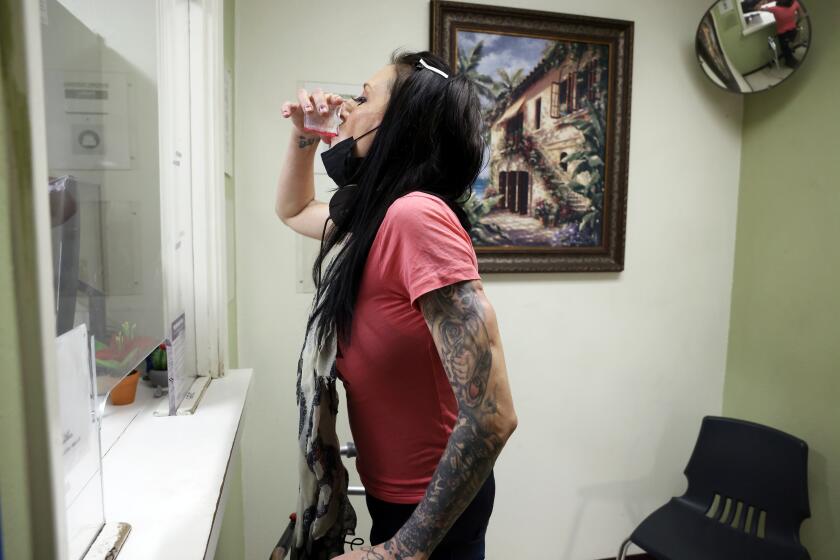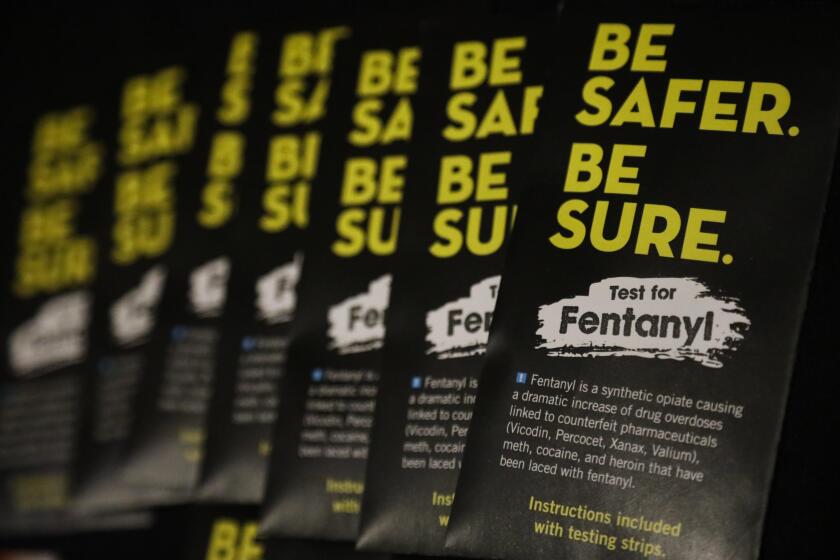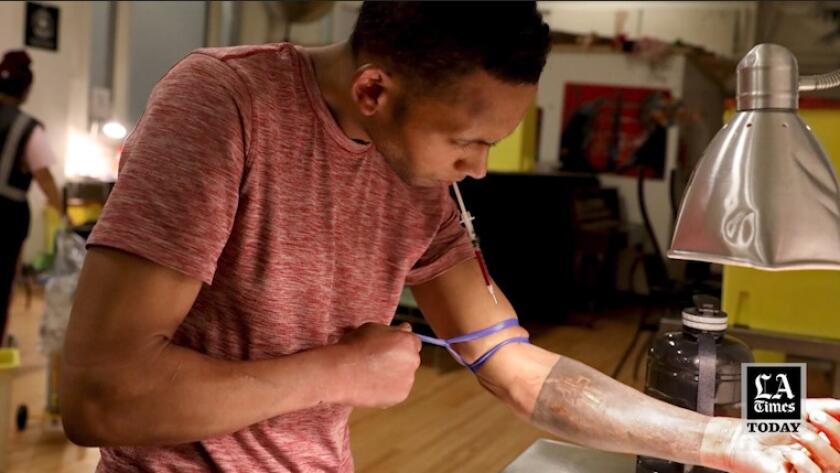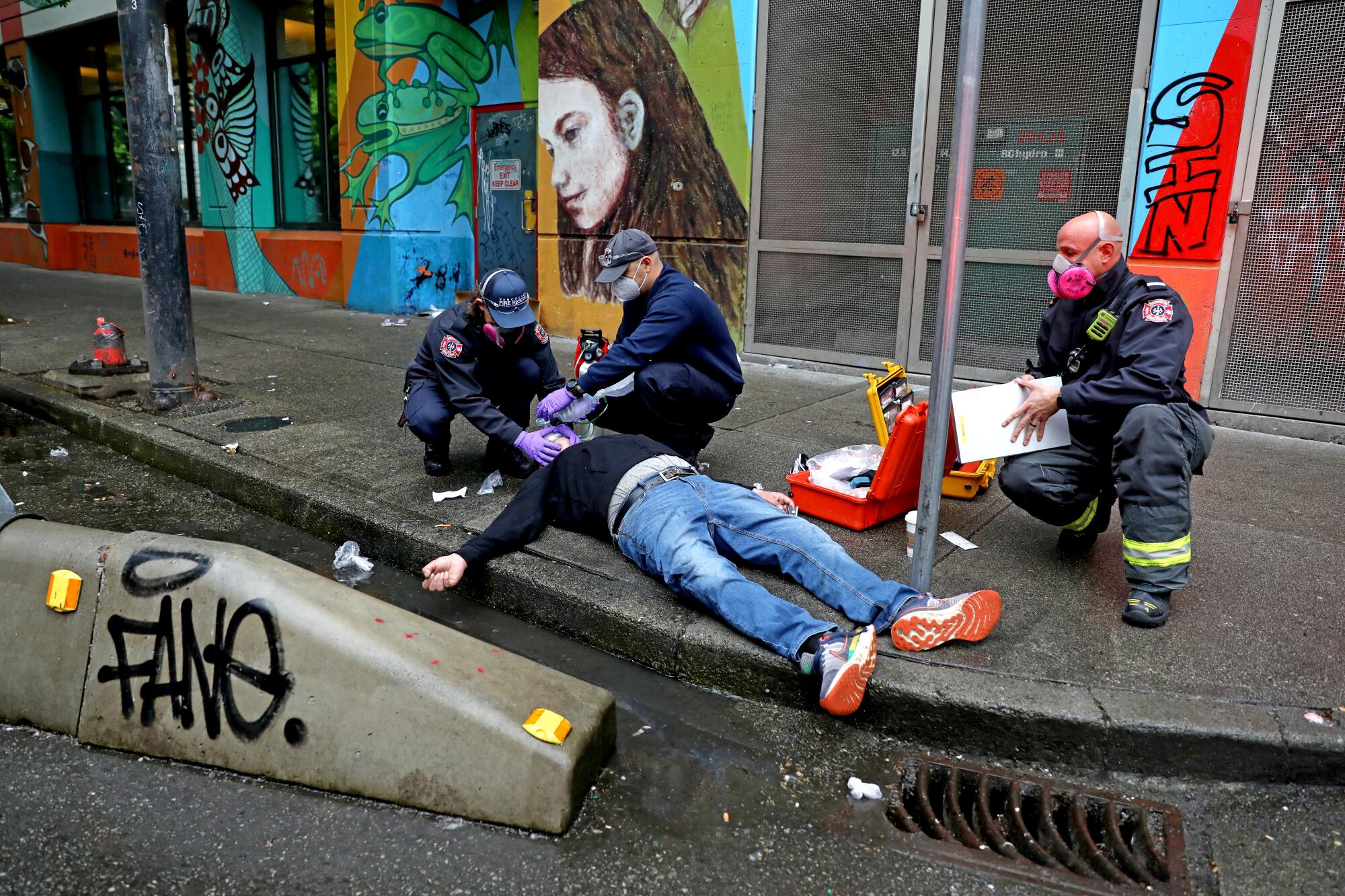
VANCOUVER, Canada — In the coastal cold of a Vancouver morning, nine people crowded at the door of the Insite safe injection center, itching for it to open so they could shoot heroin and fentanyl inside.
Around their huddle on this two-block stretch of East Hastings Street, hundreds of people, the majority habitual drug users, were crushed together in tents and chairs, on discarded rugs and under wet tarps. Some were sprawled on the sidewalk, motionless and unconscious. One man repeatedly hurled a hatchet at the pavement.
Open-use drug havens such as San Francisco’s Tenderloin and L.A.’s skid row have become notorious and contentious, but those places have nothing on East Hastings, part of a neighborhood called Downtown Eastside. In every direction, there were needles in arms and butane lighters melting chunks of fentanyl, heroin and meth — the stench of burning chemicals was unavoidable. For many residents and business owners in Vancouver’s historic Chinatown, only a block away, East Hastings means theft, garbage, graffiti and a near-constant blare of sirens.
I came to Vancouver to see what can be learned as we debate safe consumption in California, where more than 6,000 people die each year from overdoses. Think about that. Six thousand is the roughly number of Californians who die each year from traffic accidents and firearms combined. Across the U.S., one person dies every five minutes from an overdose. In California, on average, 16 perish daily.
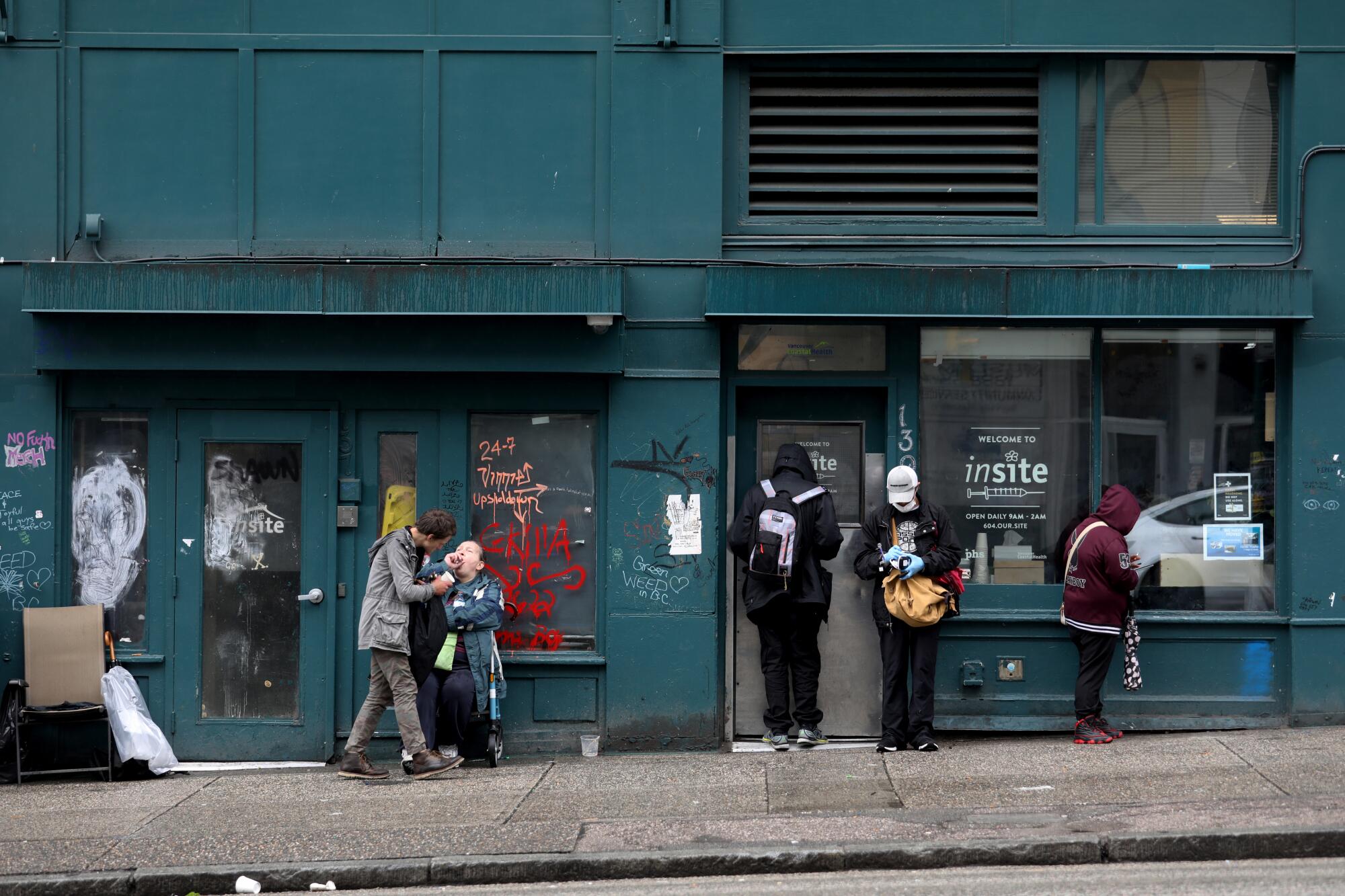
In response, California state legislators are considering opening safe injection sites like those pioneered here in British Columbia nearly 20 years ago (Insite opened in 2003), both to save lives and curtail open consumption. San Francisco is already running one such site, despite little transparency and dubious legality. A state bill could give it legitimacy (though there are still federal issues), and allow Oakland and L.A. to open their own.
But there are serious questions with essentially decriminalizing some hard drug use. Will these facilities solve problems and aid those with substance use disorders? Or only drag already troubled people and neighborhoods further into turmoil?
What I found in Vancouver is a tangle of perspectives that, at heart, comes down to whether we think success in fighting addiction has to be abstinence, or something lesser.
East Hastings makes a case for both.
I met four people — Geoffrey Bordas, Winook Wilannish, Bernie Coulson and Vance Hughes — who helped me understand the complexities of these safe consumption sites and how our war of words around them is overly simplistic. Canada figured out years ago these sites are vital. But they also are not a solution to the overdose epidemic.
That may require something even more drastic.
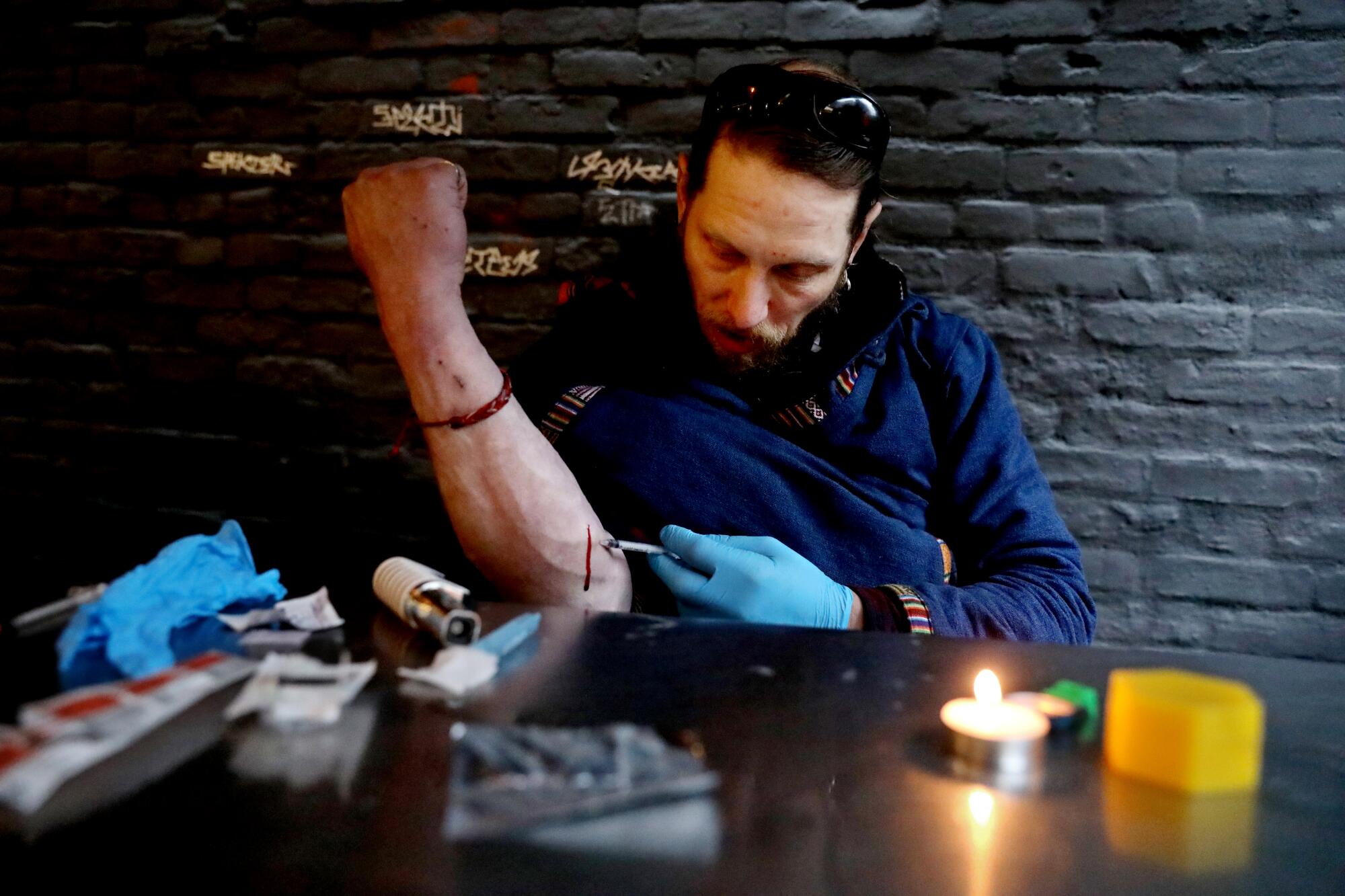
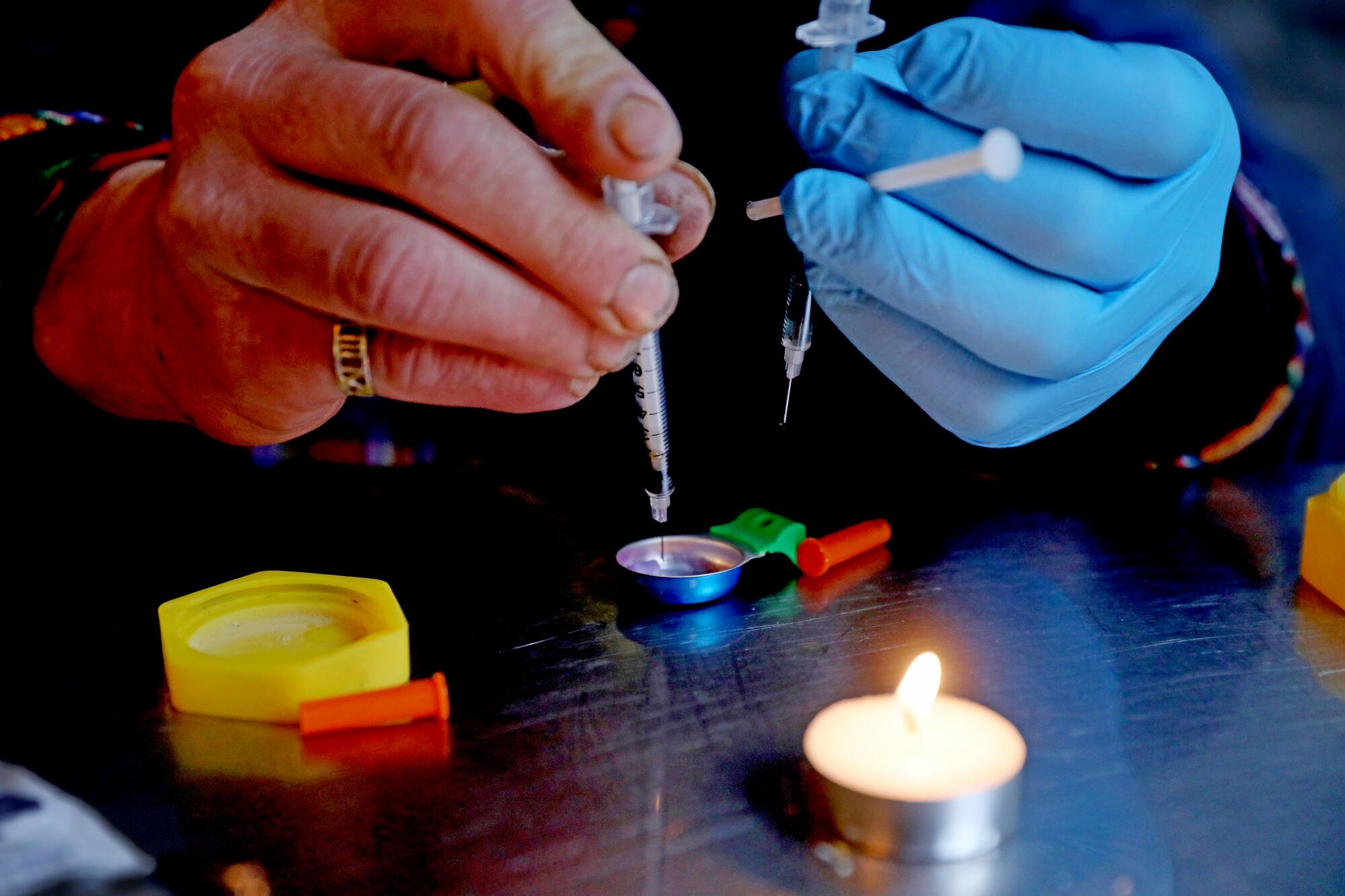
A dose of dignity
Unlike many in Downtown Eastside, Geoffrey Bordas still has good veins. They popped up from his muscular forearm when he made a fist, visible even beneath the bruises of previous injections.
I met Bordas sitting at a metal table in a safe drug consumption site that lies behind a colorful gate off what locals call Piss Alley.
Eighteen others were already in various altered states or making preparations — smoking heroin and “down,” as fentanyl is called, gathering free supplies from yellow plastic bins, socializing at picnic tables surrounded by planter boxes of pansies. A handful of volunteers, mostly addicts themselves, watched for overdoses. Black pouches of the anti-overdose drug naloxone were copious, and nearly everyone was trained to use it.
In a tin bowl the size of a quarter, Bordas melted a lavender chunk of fentanyl until it turned into an bright violet syrup. The added coloring serves as a kind of street branding. He drew the liquid through a needle, then held the syringe between his teeth as he pulled up his jacket sleeve, revealing those veins, blue under his skin.
When people on L.A.’s skid row want to try to wrench free from opioid addiction, the closest options for getting daily methadone may be miles away.
With skill, he slid the needle in and red blood burst into the barrel, swirling with the fentanyl. Bordas pushed the plunger down and the drug disappeared inside him, and he began to disappear into it — floating through the universe, talking to John Lennon, as another user described it.
The ritual was dispiriting to witness. Bordas is smart, direct, engaging. I couldn’t watch without thinking of my kids and how I would feel if Bordas were part of my family. But I was relieved he was doing it here. This safe space has provided him with an escape from the death, filth and predation outside, and something more. It’s a “place where the stigma doesn’t follow you everywhere,” Bordas said before he left our reality. “It becomes a community.”
Bordas has been coming here for roughly a year. Twice a week, when he is not using, he volunteers to monitor while others do. He’s reversed multiple overdoses, just as he’s had overdoses reversed multiple times. At first it freaked him out when someone went down, but now that he’s done it so many times, he’s calm and focused.
Sarah Blyth, the unofficial mama bear of East Hastings who started this facility, said users make the best monitors because they understand the people they are saving. The dignity of being helped without judgment, and being the helper without judgment, may be the first step toward recovery — giving people a reason to value themselves when society largely doesn’t. There is a kindness and depth in that acceptance that I didn’t understand until I was in its midst.
For Bordas, being a volunteer brings him a sense of purpose.
“I am a hard worker. I have always worked my entire life,” Bordas said. “We are productive people. Just give us a chance.”
The help trap
Overdose prevention sites are part of a growing push for “harm reduction” strategies that aim to prevent drug users from being stigmatized or jailed, and focus on removing physical and emotional obstacles to treating their addictions.
In Vancouver, harm reduction has been long established. The Downtown Eastside is filled with methadone clinics, primary care providers (Canada has socialized medicine and family doctors treat addiction) subsidized housing, shelters and a myriad of aid organizations.
The government agency in charge of health programs in Vancouver and surrounding areas spends at least $350 million annually on substance use and mental health, serving about 1 million people.
Winook Wilannish thinks all that harm reduction has become a harm in itself.
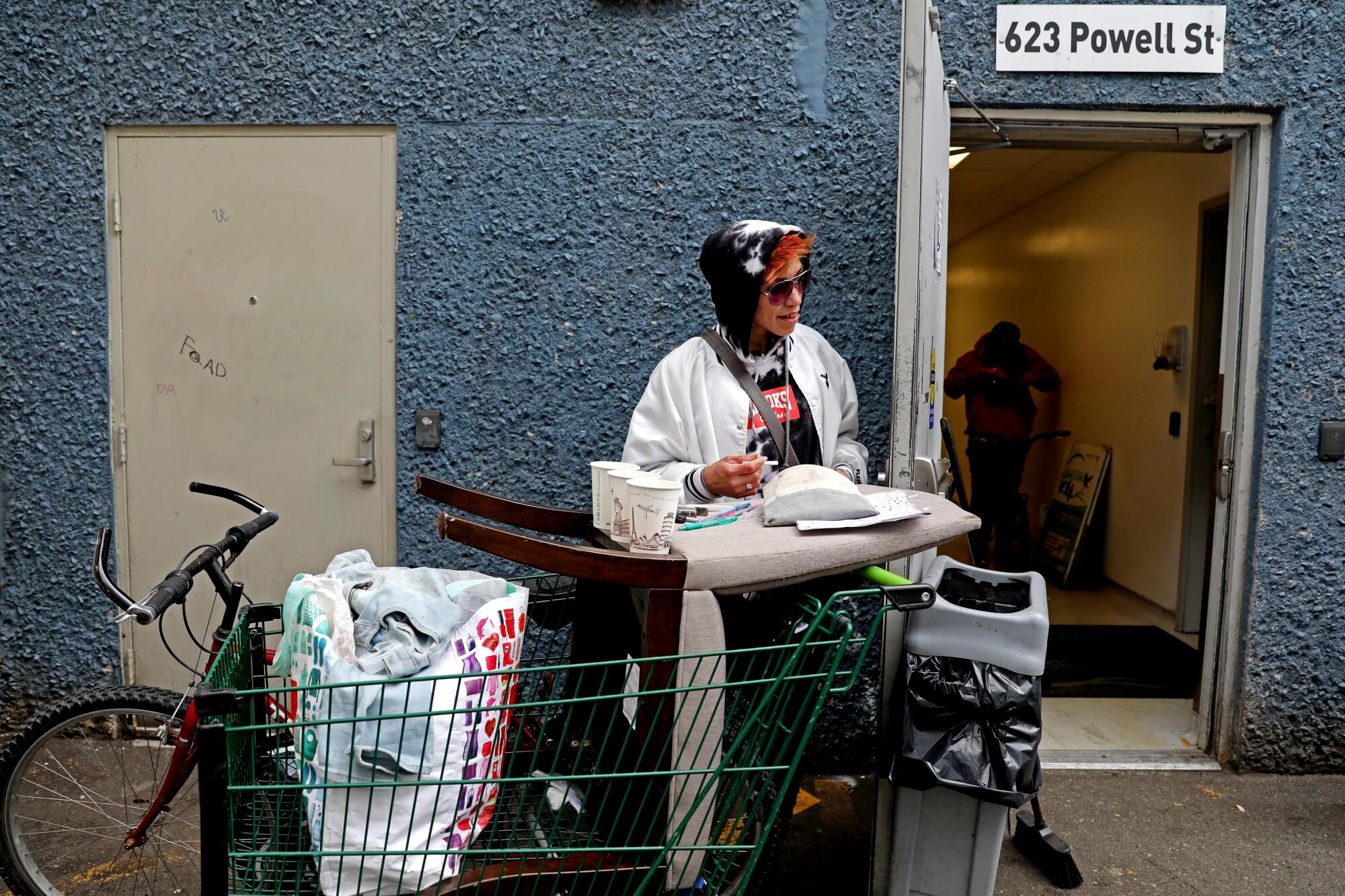
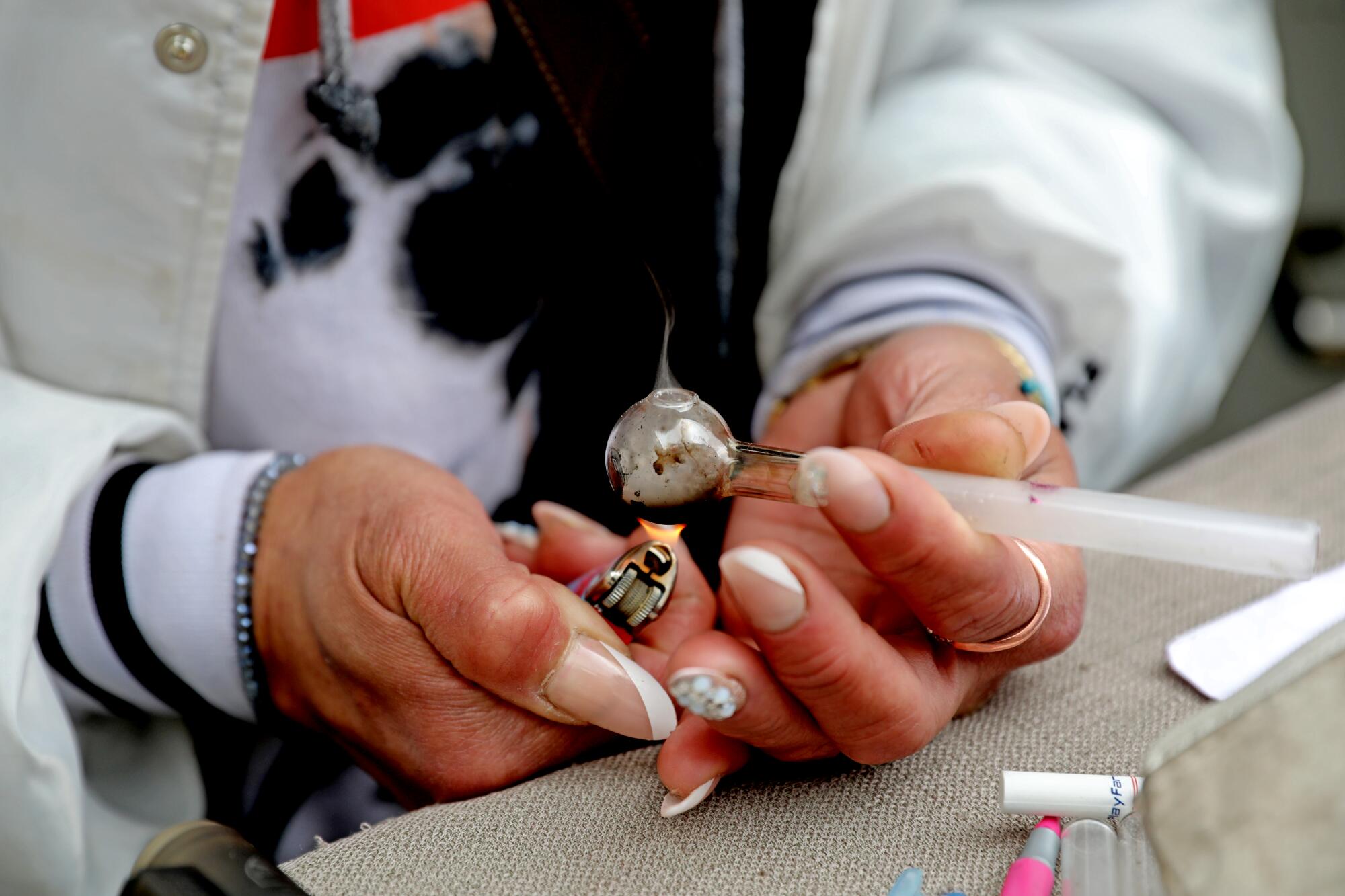
I met her in another alley, this one kept nearly spotless in deference to the gentrified condos on one side — some of which sell for more than $1 million Canadian (about $766,000 U.S.).
Without the shopping cart she guarded, and the smattering of fentanyl she held on a square of foil, she could have been mistaken for a hipster residing in one of those refurbished dwellings: white satin Playboy jacket, purple-tinted aviator glasses and lean, angular features that reminded me of Zoë Kravitz.
Wilannish is Indigenous and said her fourth great-grandfather was Wickaninnish, a chief of the Tla-o-qui-aht people of Clayoquot Sound, once one of the most respected and powerful tribes of the Vancouver Islands. She has a teenage son back there and it makes her cry to think about him.
She has been in Downtown Eastside since 2008. Before that, she was clean for 13 years, had a house and a career.
Substance abuse has hit hard in Canada’s Indigenous population, as it has among Black and brown communities in the United States. Yet Wilannish believes that all the help offered in this neighborhood holds her down. “There is a fine line between enabling and keeping someone safe,” she said, “and they’ve crossed it a long time ago.”
She was standing outside a government-funded clinic where methadone is dispensed into disposable cups. Inside were a half-dozen people. A man tapped at the keys of a computer while, next to him, an unconscious man slumped in a chair, head slung back, mouth open. A third man, still holding his methadone cup, had wet his pants and stood swaying with eyes closed.
Wilannish said she feels like her addiction is treated “like a lifestyle,” rather than something to be overcome.
“They are happy to have us here forever,” she said. “That kills me.”
Scenes along Vancouver’s East Hastings Street
Pragmatic prescription
Bernie Coulson has had plenty of chances to get off East Hastings, but that’s where I met him anyway.
He wore a bright blue sweater that matched his eyes and had the weathered look of a longtime user. But it was still easy to see the charisma, intelligence and charm that almost made him a movie star — there’s a crackling energy in those eyes that is irresistible.
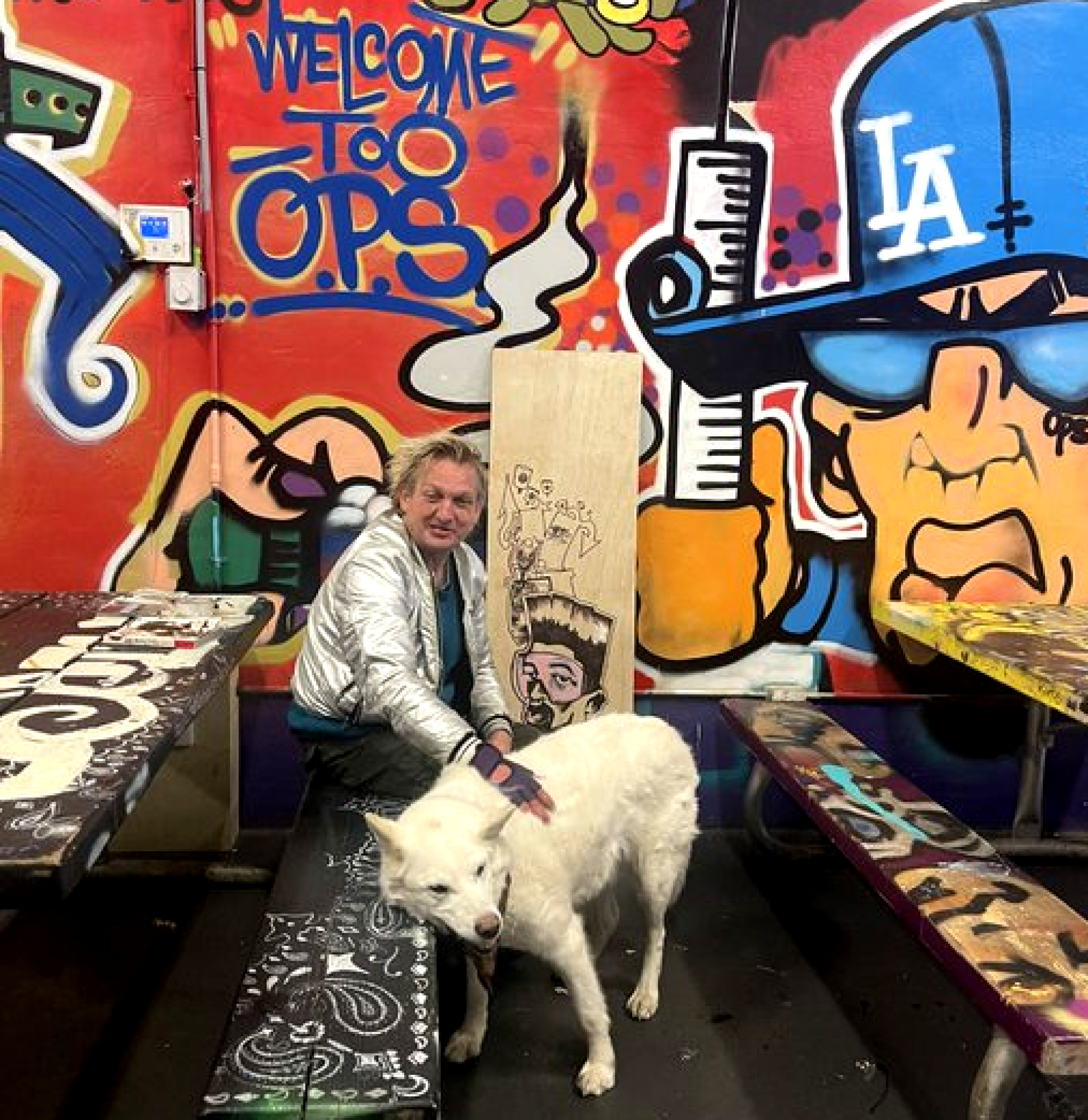
In the 1980s, he was roommates with Brad Pitt and Jason Priestley, sharing a rundown apartment in North Hollywood before Pitt and Priestley made it. Coulson was on his way, too — in 1988, when Pitt was appearing on “21 Jump Street,” Coulson played a key role in “The Accused.” He’s been in “The X-Files,” “Psych” and the 2016 indie film “Dark Harvest.”
For awhile, he managed to act and do drugs. But around 2011, he said, he decided drugs were more important than work. So he stopped acting, or stopped landing jobs, anyway. Now, he’s ready for a comeback. He’s finished two screenplays and signed up for an advanced acting class to “get my chops back up,” he told me, standing at a noisy intersection as ambulances roared by.
“This old wicked boy [is] turning righteous as I try to walk a straight line,” he intoned with campy flair.
But he’s not off fentanyl. Around the corner, Dr. Christy Sutherland, a family physician, is distributing a “safe supply” of the opioid to 15 patients, including Coulson. Working with a pharmaceutical company, Sutherland has created a pure powder that comes in capsules that range from 1,000 to 5,000 micrograms — legally prescribed.
Coulson is on a 2,500 microgram dose, he said — patients in hospitals receiving fentanyl for pain are given about 12 micrograms, Sutherland told me. Her average patient takes about 4,000 micrograms four times a day.
When she first started her project, she was surprised by the large dose her patients needed to mimic their street high. The power of fentanyl, as much as 100 times the strength of heroin, and the amount street users are doing may explain why established opioid replacement therapies such as methadone aren’t effective for some.
Details, details, details
Prescription fentanyl, Sutherland said, is the only practical decision. She is tired of seeing her patients trapped by the sex work, stealing, incarceration, victimization and other harm that comes from sometimes needing upwards of $100 a day to pay for dirty and illegal drugs. She is tired of seeing them die.
In Vancouver, many of the opioids sold on the streets are mixed with benzodiazepines, a set of sedatives that can cause memory loss and last longer than fentanyl or heroin alone. But benzodiazepines are also immune to naloxone during an overdose. That has created a deepening crisis for Vancouver of “benzo-dope” deaths, along with the horrifying reality of users facing sexual assaults, robberies and other abuse they can’t recall.
Fentanyl is often mixed with other drugs (including heroin, methamphetamine and cocaine) to increase potency, but it can be deadly. Test kits can help.
Benzodiazepine-laced drugs are also on the rise in California, as is smoking fentanyl.
But Sutherland said even without benzo-dope, and even with the best intentions and care, people will cycle on and off of drugs. Addiction is a chronic condition that seldom ends in permanent abstinence, despite what family and society wants, she said.
She sells her capsules at street prices to avoid the temptation for patients to resell, she doesn’t make a profit, and doesn’t plan to. But she would like to see safe supply be the new standard, beyond safe consumption.
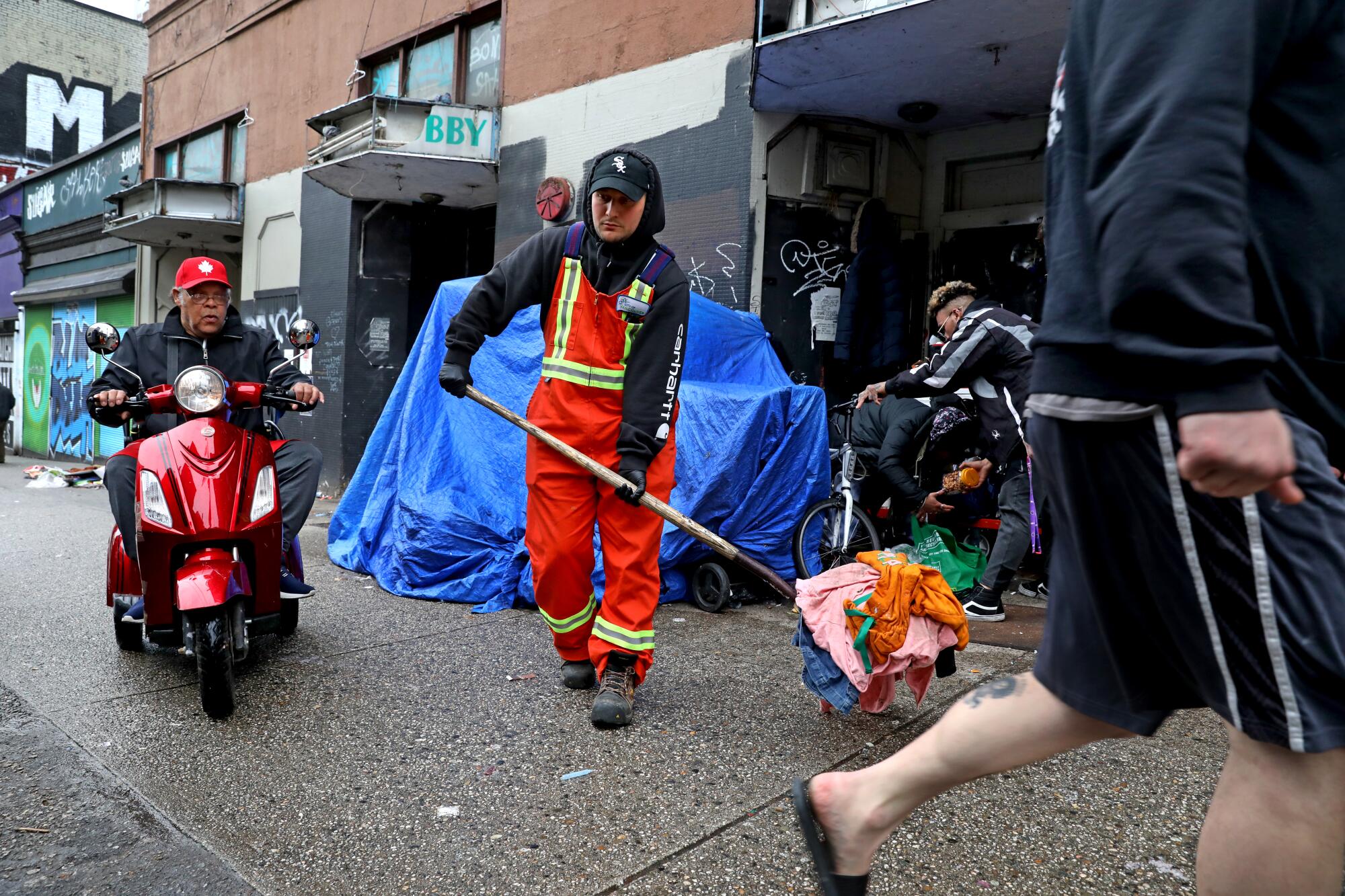
Vancouver Mayor Kennedy Stewart agrees. He thinks safe consumption sites are just a “Band-Aid.” Every Monday he receives an email he dreads opening — the tally of how many people overdosed and died the previous week. Each day, one person dies —sometimes more.
Stewart has lost one family member to an overdose; another has survived multiple overdoses. For many people, he said, a drug-free life isn’t a realistic or necessary goal and demanding it is a one-way ticket to failure — for both people and policy.
“That’s really just denial,” said Stewart of the abstinence ideal. “Success is a healthy person to me, and if that healthy person also happens to be a drug user, that’s fine.”
Coulson, the onetime actor, said the capsules are working for him, though he misses that “zaza” of a good batch of street drugs. But the powder curbs cravings and, better, lets him get on with his day. He said he feels like he can focus on other parts of his life and eventually quit.
“It’s stopping me from wanting to partake out here,” he said, before bounding off into the chaos of East Hastings.
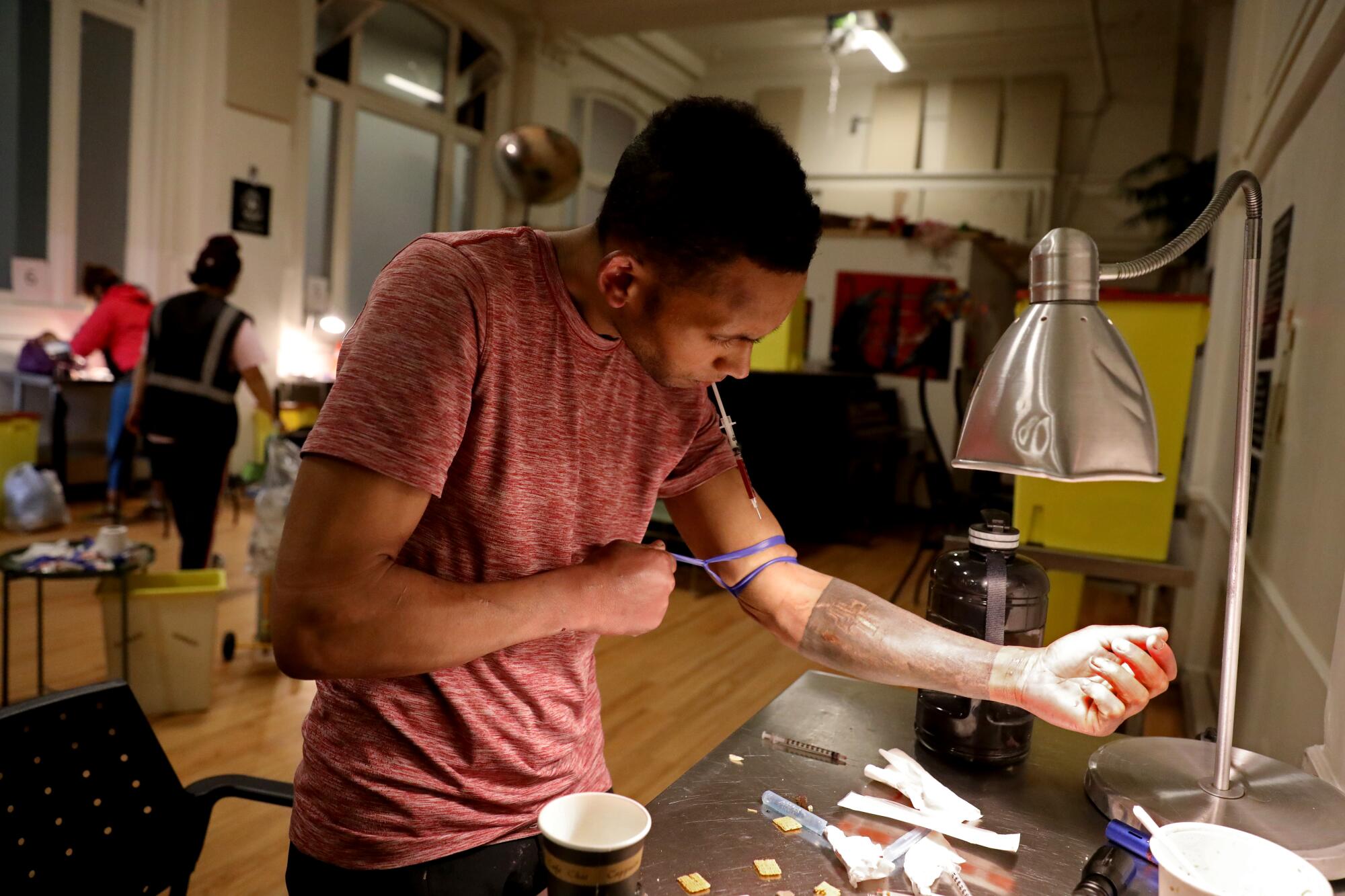
Staying alive
Nothing seems to be stopping Vance Hughes.
When I met him he was high, clutching a jug of orange juice in his hand, with an open sore that looked infected. Hughes has been around East Hastings for decades, 20 or 30 years — since he was 8 years old, he said, though I hope that’s not true. Those who know him describe him as not right anymore. A “switch has been flipped,” as one person put it. Sometimes he screams at others until they give him drugs to make him go away.
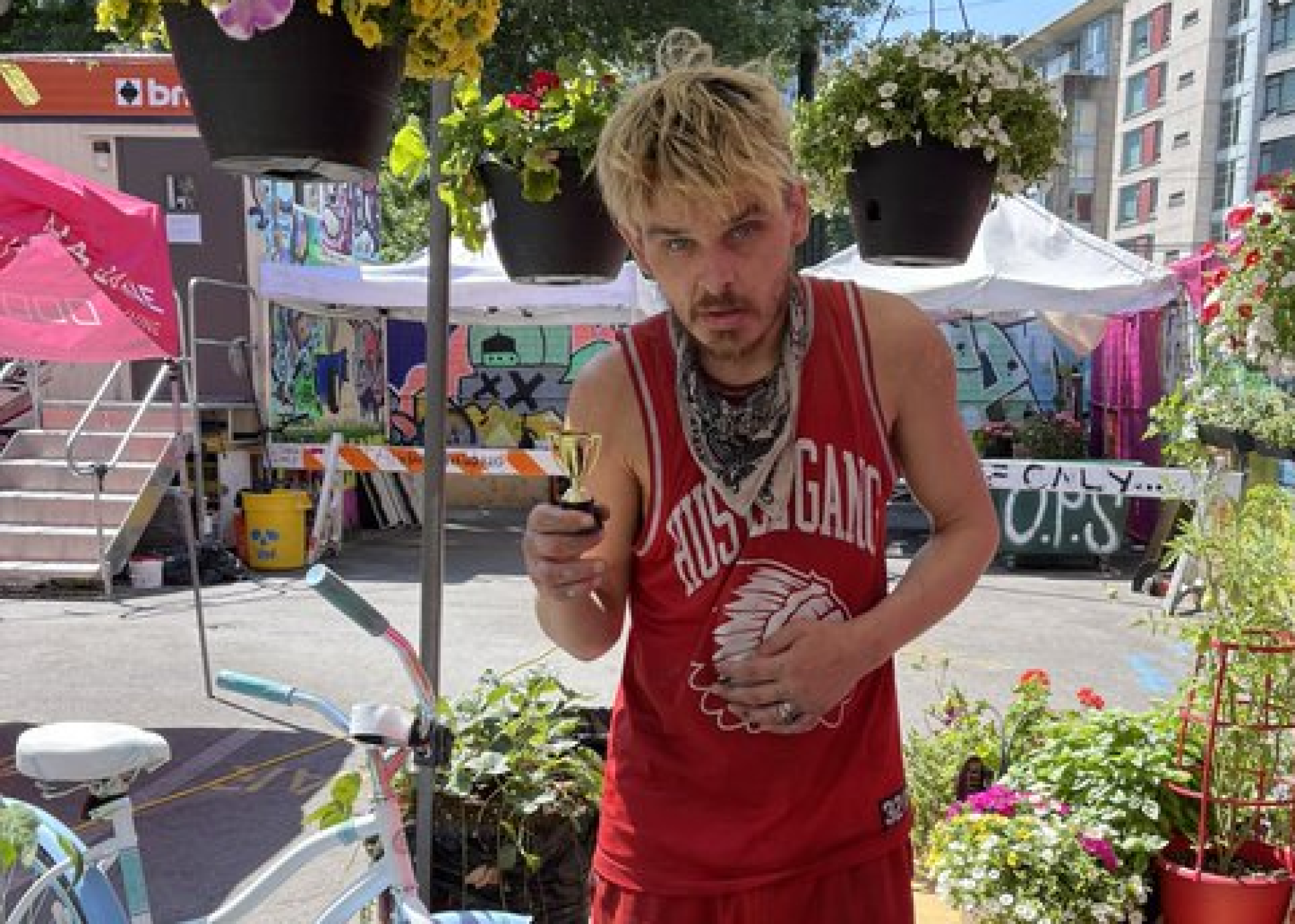
But when I spoke with him, he was just sad, and defeated, hunched over and crying. He has no friends, he said, and people around here call him a rat and a goof, slang for a child molester.
“They hurt me and they don’t want to be nice to me,” he told me. The overdose prevention site is the only place he finds kindness.
He can’t think of a reason to live. But something in him, that undefinable human spirit, keeps him going. He dreams of “finding someone who wants to get out of here and have a family, have babies with me,” he said. “But I don’t have any luck.”
He doesn’t see himself getting off heroin anytime soon, and I can’t argue with him. I don’t know that he has the capacity to be a fully functioning member of society, as we judge it, and I don’t think jail or forced treatment would change that.
People like Hughes should be our focus when we are thinking about the extremes of our policies. Whether helped or left to his own devices, he represents a moral and economic cost to society, and tough questions:
How far are we willing to go to help those whose addictions may always define their lives? What does compassion demand? What’s pragmatic?
And are we ready to discuss safe supply — the inevitable next idea if we open safe consumption sites only to find that clean syringes don’t matter if they deliver poison?
Opening safe consumption sites is a no-brainer to me. They do save lives, and they do provide a first step toward stability. They aren’t gateways to addiction, and teens won’t stumble in to be handed drugs and needles — by the time you wind up in one, you know drugs.

But they aren’t solutions to the opioid crisis. They don’t address the uncontrolled flow of tainted drugs to our streets, with ever-worsening ingredients. They don’t acknowledge that gentrification, racism and NIMBYism have squeezed poor users and unsheltered people into shrinking areas like East Hastings and The Tenderloin, where nonusing residents are left with an unfair burden. They don’t make it easier, as Wilannish said, to pinpoint that line between enabling and helping.
But they do keep people like Hughes and Bordas alive.
Maybe that’s enough, while we muddle through the rest.
Watch L.A. Times Today at 7 p.m. on Spectrum News 1 on Channel 1 or live stream on the Spectrum News App. Palos Verdes Peninsula and Orange County viewers can watch on Cox Systems on channel 99.
More to Read
Sign up for Essential California
The most important California stories and recommendations in your inbox every morning.
You may occasionally receive promotional content from the Los Angeles Times.
